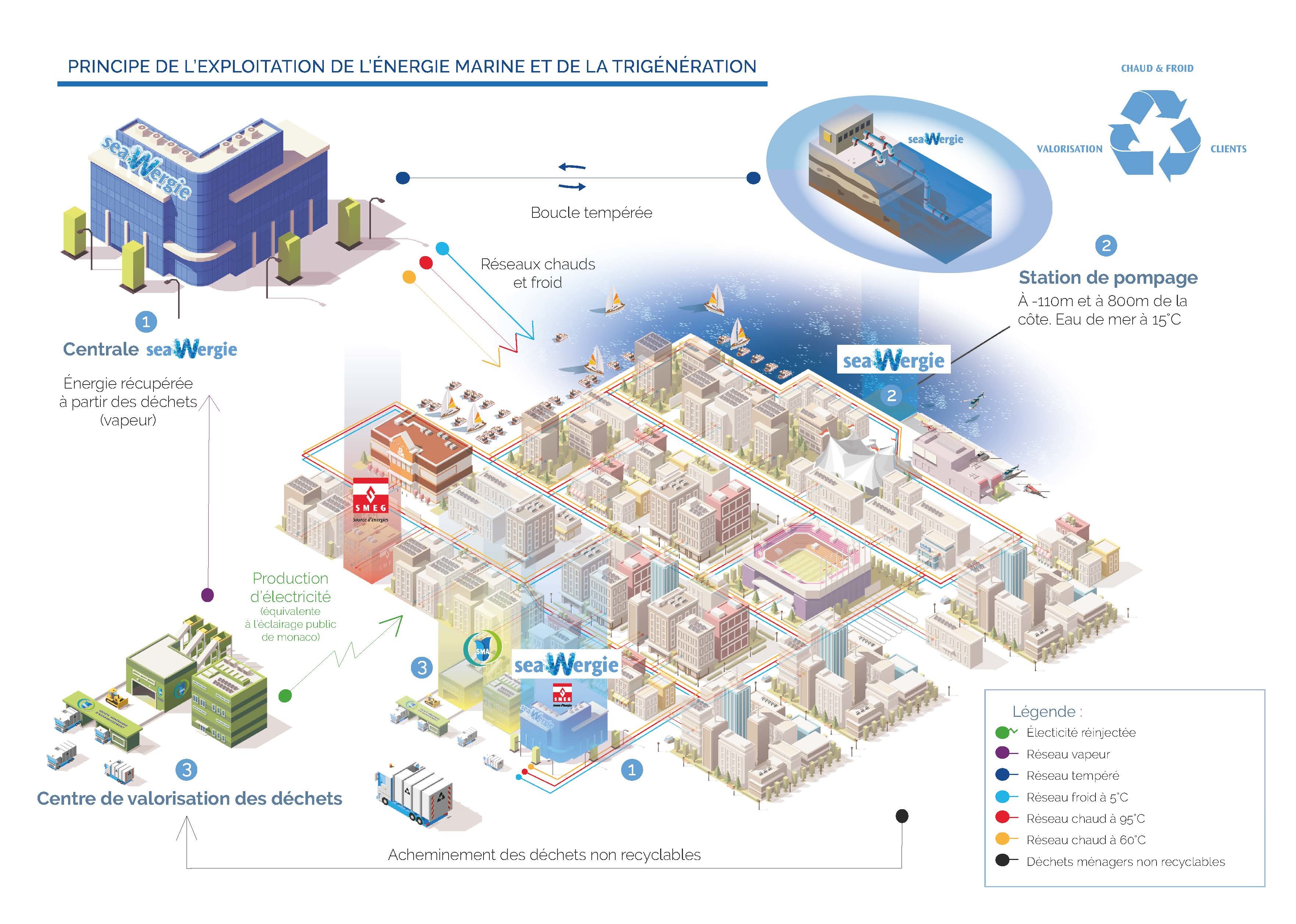seaWergie, Urban Heating and Cooling
SeaWergie, a sustainable development tool for the Principality

The heating and cooling plant is connected to the waste recovery centre (CVD) and to an underground seawater pumping station built into the Fontvieille sea wall. The energy is supplied by insulated pipe networks running under the roadway to the connected buildings.
The plant recycles energy from household waste in three forms:
- Electricity, partly redistributed on the public network
- Hot water, distributed to heating networks to heat buildings and produce domestic hot water. This avoids the emission of 6,000 tonnes of CO2 per year.
- Chilled water, distributed via the cooling network, is used to air-condition commercial and residential buildings and industrial processes.
Thanks to this TRIGENERATION principle, the Monaco plant is able to use the energy from waste in its cooling network to air condition buildings. The advantage is twofold: reduced electricity consumption and use of locally recovered energy.
Since 2013, the buildings connected to the network have been air-conditioned in a sustainable and environmentally-friendly way, using seawater from a depth of 110 metres:
- It avoids the consumption of fresh water: - 100,000 m3 of water per year,
- Improves the energy efficiency of production,
- Eliminates the risks associated with legionella.
Heating and cooling networks fit in perfectly with modern, dense urban planning with vertical housing. They adapt easily to architectural constraints. In particular, they eliminate the need for condensers or chimneys on roofs.
Compared with stand-alone production in buildings, urban networks are much quieter (no chillers in buildings, no rooftops). Security of supply is guaranteed by regular maintenance of the delivery stations and a 24-hour remote surveillance system. With its energy mix favouring local, renewable and recovered energies, seaWergie is playing an active role in Monaco's energy transition and in sustainable development in the Principality of Monaco.
How does it work?
- The production plant produces the hot and chilled water that is sent to the delivery stations in the urban network.
- Networks of urban pipes run under the roadway, mainly in service tunnels that can be visited, to transport the hot and chilled water to the buildings supplied.
- Each building connected to the network is equipped with a heat and/or cold delivery station. The delivery station supplies heating, domestic hot water and air conditioning to the building's secondary piping systems.
An urban heating network operates like a large central heating system for a whole city or district. The heat produced locally from several energy sources, particularly renewable and recovered energy, is transported to users in the form of hot water via interconnected underground pipes. Comfort and safety for users, respect for the environment: the heating network meets the challenges of the energy transformation of cities. The cooling network operates on the same principle.

A few figures
- 1 10-storey energy production plant located in the city centre, with 3 km of networks serving the Western part of Monaco.
- 95% of annual heating energy produced from steam
- 30% of annual cooling energy produced from steam
- 1 seawater pumping station 800 m off the coast and 110 m deep
- 17,500 kW of installed heating capacity
- 19,100 kW of installed cooling capacity
- 38,000 kW of seawater cooling capacity
- 57 heating/cooling delivery stations for 33 connected buildings
- 30 hectares served by the networks
- 21 GWh: Heat delivered in 2017
- 6,000 tonnes of CO2 avoided per year through heat production
- 20 grams CO2 / kWH *: CO2 content of the heating network
- 2100 housing equivalents heated and air-conditioned
- 33 GWh: Cooling delivered in 2017
- 0 g/kWh**: CO2 content of cooling network
Consult the service regulations
* Heating production from fossil fuels carbon offset through the ECO2 offer for gas, and by the Prince Albert II Foundation for heavy fuel oil, i.e. 0 g CO2/kWh compared with the French average for urban heating networks of 126 g CO2/kWh (2016 figure).
**Cooling production: Use of guaranteed renewable electricity thanks to the EGEO contract. The steam comes from the waste recovery centre.
For further information, contact our Customer Relations Department



